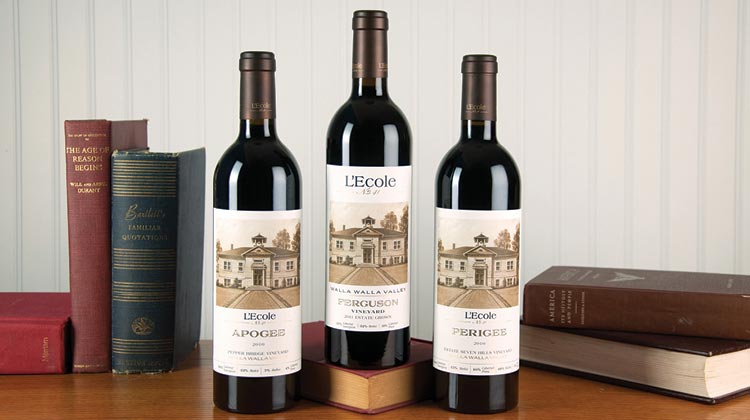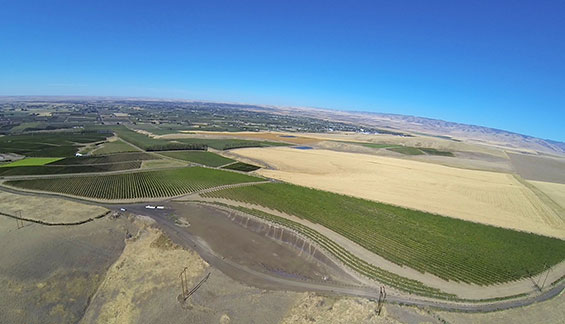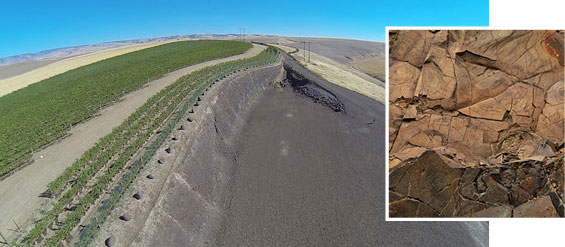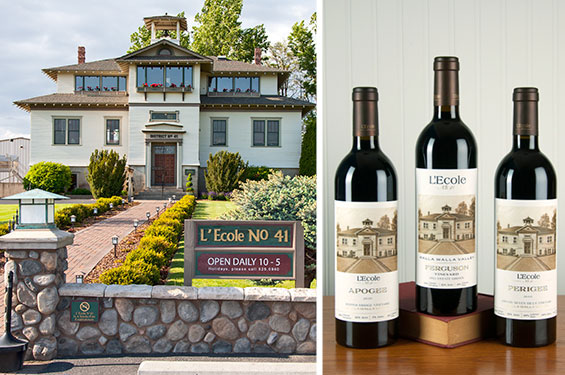
Founded in 1983 by Jean and Baker Ferguson, L’Ecole Nº 41 is nothing short of a Walla Walla Valley icon. It was the third winery established in the valley and remarkably, at that time it was one of only 20 wineries in a state that now boasts more than 800.
L’Ecole is located in Frenchtown, just west of Walla Walla, in a historic schoolhouse built in 1915. Thus the name L’Ecole, which means, the school. The schoolhouse (whose image adorns the winery’s label) stands as the gateway to the valley, a near-obligatory stop for anyone traveling to the area.
Second-generation owner Marty Clubb has shepherded the winery’s evolution since 1989, growing production to over 40,000 cases annually, and becoming the largest producer of Walla Walla Valley AVA wines. As the winery has grown, quality has remained L’Ecole’s benchmark with a long list of accolades and accomplishments added to its name over the decades.
The past twelve months have brought an abundance of reasons for Clubb to celebrate, with both the winery and the Walla Walla Valley AVA celebrating 30th anniversaries. This year, L’Ecole also released its first vineyard-designated wine from its new estate vineyard, Ferguson, which won the prestigious International Trophy for Best in Show Red Bordeaux over £15 (equal to $25) at the 2014 British Decanter World Wine Awards, possibly the world’s largest wine competition.

Viticultural Frontier
Looking out from Ferguson Vineyard in the southern section of the Walla Walla Valley, the whole valley spreads out like a picture postcard titled America the Beautiful. To the east, the stately Blue Mountains rise steeply from the valley floor. Gazing northward, the landscape slopes downward toward the city of Walla Walla before rising back up into the seemingly endless Palouse. Vansycle Ridge stretches off to the west, dotted with slow-churning wind turbines while further south, golden wheat fields undulate into the distance. It’s as breathtaking a spot as one will find in a valley known for its majestic vistas.
Ferguson Vineyard is more than just another pretty face of the Walla Walla Valley—it is also one of the valley’s viticultural frontiers.
Named after L’Ecole founders Jean and Baker Ferguson, Ferguson Vineyard sits along a ridgetop above Dry Creek, a short distance from Seven Hills Vineyard where L’Ecole has long had estate plantings.
Planted in 2008, it is part of the ambitious SeVein project that encompasses 2,700 acres of land in the Walla Walla Valley. Conceived by partners Gary Figgins, Chris Figgins (both of Leonetti Cellar and Figgins Family Wine Estates), Marty Clubb (L’Ecole Nº 41), Norm McKibben (Pepper Bridge and Amavi), and Bob Rupar (Nelson Irrigation), the SeVein project stands to more than double the acreage of the Walla Walla Valley once all of the available land is planted. Some of this land, such as L’Ecole’s Ferguson Vineyard, will also provide a unique prism through which to view the valley’s terroir.
With elevations up to 1,500 feet above sea level, Ferguson is considerably higher than most other vineyards in the Walla Walla Valley. For Marty Clubb, co-owner and managing winemaker of L’Ecole, that higher elevation has appeal. “We knew that the top of the ridge had the thinnest soil overlying fractured basalt and would be a completely different wine profile from Seven Hills Vineyard itself,” Clubb says of his decision to plant at the site. He also believes that the closeness of the basalt to the surface could have a direct effect upon the resulting wines.
“In France, there are certain producers that actually grind basalt and put it in the field because of its mineral content,” Clubb says. “At Ferguson the soil is so thin that the vines are actually able to grow down into the basalt, so there’s a very different mineral composition with higher concentrations of iron.”

The thin interface between the soil and the basalt bedrock at the upper reaches of Ferguson is dramatically illustrated at a quarry next to the vineyard where a wall of basalt is exposed. Above it are vineyard rows with as little as eighteen inches of soil. The rock along the wall is surprisingly friable, falling apart and crumbling to the touch, with innumerable cracks and fissures. “The closer the basalt got to the surface, the faster it cooled causing it to fracture,” Clubb explained. “So just like a pane of glass that has been hit, the rock is shattered.”
Though the vineyard is still young, Clubb believes he’s seeing the influence of the basalt in the wines. “We don’t have that many years of experience yet, but what we’re seeing is that the basalt creates a darker, denser fruit profile with coffee and espresso tones,” he said. “There’s a minerality, almost a blood iron minerality that is unique.”
There were other reasons Clubb sought out a higher elevation site at SeVein. Ferguson’s elevation—along with the persistent wind that whips through the area—helps protect the vineyard from the Walla Walla Valley’s greatest environmental threat: periodic frosts and freezes that occur when cold air pools at lower elevations. “It is still not clear if we need wind machines that high or not,” Clubb said of the devices many farmers in the valley use to help combat cold temperatures.
Uniquely Walla Walla
This spring, L’Ecole released its first Ferguson Vineyard designated wine, a blend of Cabernet Sauvignon, Merlot and Cabernet Franc from the 2011 vintage. (Grapes from this site are also used in the winery’s 2011 Estate Merlot and Walla Walla Valley Cabernet Sauvignon.) Clubb said the Ferguson red blend provides an interesting contrast to L’Ecole’s Pepper Bridge and Seven Hills Vineyard designated blends.
“They are three completely different wines, each representing unique aspects of the Walla Walla Valley,” Clubb said. “Pepper Bridge is right in the drainage of the Blue Mountains where it’s cooler so the vineyard is later maturing and the wine has a kind of darker structure along with more leather, tobacco, and spicy fruit tones. Seven Hills is at a windy, warm, higher elevation with deep soils and tends to produce these very pretty, floral aromatics, cherry, cedar and a silky, velvety tannin structure. At Ferguson, we’re seeing a darker complexion in the fruit, higher natural acidity because of the elevation and what I believe to be a basalt driven minerality that is really unlike either of the other two vineyards.”
L’Ecole currently has 18 acres planted at the site with room for 24 more. Clubb expects the SeVein project, with sites like Ferguson, to have a substantial impact on the Walla Walla Valley in the years to come. “There are now a number of super premium wineries developing estate vineyards on these hillsides,” Clubb said. “The combination of unique soil, air drainage, and access to high quality water is a combination that is getting harder to find.”
Written by Sean P. Sullivan
Click here to view this article as published in Tasting Room Magazine.

Editor’s Top Picks
L’Ecole Nº 41 2011 Estate Ferguson Walla Walla Valley, $59
The winery’s stunning single-vineyard Bordeaux varietal blend marks the inaugural release from their new estate Ferguson Vineyard in Washington State’s Walla Walla Valley. Truly a brilliant offering from a vineyard this young.
Blend: 57% Cabernet Sauvignon, 32% Merlot, 11% Cabernet Franc
Nose: Expressive and pronounced with aromas of dark roasted espresso bean, tar, currants, mesquite and graphite.
Taste: Impeccably structured. Powerful, dark and concentrated with a lush palate dominated by brawny tannins. Flavors of generous black fruit, currants and singed herbs backed by a sheen of iron minerality. Hints of rich black tea show through the lengthy and complex finish. – J. Vitale
L’Ecole Nº 41 2010 Perigee Seven Hills Vineyard, $49
An elegant estate Bordeaux varietal blend from the esteemed Seven Hills Vineyard in the Walla Walla Valley. This site is reknown for its earthy yet delicate and richly floral qualities.
Blend: 60% Cabernet Sauvignon, 15% Merlot, 10% Cabernet Franc, 10% Malbec, 5% Petit Verdot
Nose: Enticing florality of red and black fruit, roses, violets, tobacco leaf and dried herbs.
Taste: Velvety tannins and a seamless core of steeped blackberries, raspberry coulis and cassis, lightly dusted with cocoa powder. The long finish is graceful and refined with lingering tea and tarry undertones. – J. Vitale
L’Ecole Nº 41 2010 Apogee Pepper Bridge Vineyard, $49
This powerhouse Bordeaux varietal blend is L’Ecole’s 17th vintage from the famed Pepper Bridge Vineyard in the Walla Walla Valley. A prolonged Indian summer allowed longer hang-time for the grapes, resulting in excellent balance and depth of flavors.
Blend: 56% Cabernet Sauvignon, 33% Merlot, 7% Malbec, 4% Cabernet Franc
Nose: Shades of dark fruit, pencil lead and savory spice.
Taste: There’s a muscular edge driven by a solid core of rich dark fruit, cassis, tea leaf and minerality. Pure and polished with bold chewy tannins and a lick of spice on the finish. – J. Vitale
Visit L’Ecole Nº 41 Winery
41 Lowden School Rd, Lowden
Open daily: 10am-5pm
Phone: 509-525-0940
www.lecole.com
L’Ecole Reserve Tasting Experience
A private tasting of five wines, including new releases, library wines or limited production wines, in the cellar of the historic 1915 Frenchtown Schoolhouse.
When: Fridays 3pm
April-Nov.
Reservations required
